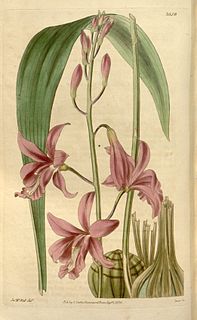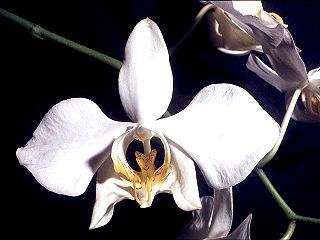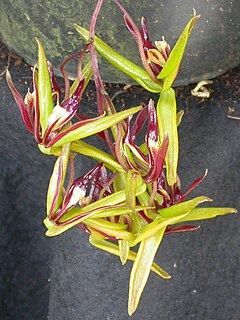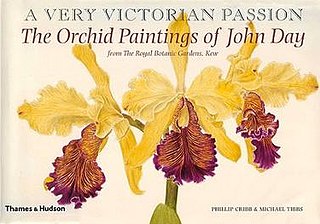
A pollinium is a coherent mass of pollen grains in a plant that are the product of only one anther, but are transferred, during pollination, as a single unit. This is regularly seen in plants such as orchids and many species of milkweeds (Asclepiadoideae). Usage of the term differs: in some orchids two masses of pollen are well attached to one another, but in other orchids there are two halves each of which is sometimes referred to as a pollinium.

Heinrich Gustav Reichenbach was a botanist and the foremost German orchidologist of the 19th century. His father Heinrich Gottlieb Ludwig Reichenbach was also a well-known botanist.

Aganisia is a small South American genus in the orchid family (Orchidaceae), subfamily Epidendroideae.

Bletia is a genus of about 30 species of orchids, almost all of which are terrestrial; some are occasionally lithophytic or epiphytic. It is named after Spanish botanist and pharmacist Don Luis Blet. The genus is widespread across Florida, Mexico, Central America, the West Indies, and South America as far south as Argentina.

Neotinea ustulata is a European terrestrial orchid native to mountains in central and southern Europe, growing at up to 2,400 m (7,900 ft) elevation. The plant is considered Endangered in Great Britain and Least Concern internationally based on IUCN Red List criteria. The burnt-tip orchid was voted the county flower of Wiltshire in 2002 following a poll by the wild flora conservation charity Plantlife.

Phalaenopsis amabilis, commonly known as the moon orchid or angrek bulan, is a species of flowering plant in the orchid family Orchidaceae, native to the East Indies and Australia, and widely cultivated as a decorative houseplant. It is an epiphytic or lithophytic herb with long, thick roots, between two and eight thick, fleshy leaves with their bases hiding the stem and nearly flat, white, long-lasting flowers on a branching flowering stem with up to ten flowers on each branch.

Cirrhaea is a genus of orchids, comprising 7 recognized species, all endemic to Brazil.
Peter Geoffrey Taylor (1926–2011) was a British botanist who worked at Royal Botanic Gardens, Kew throughout his career in botany. Taylor was born in 1926 and joined the staff of the herbarium at Kew in 1948. He published his first new species, Utricularia pentadactyla, in 1954. In 1973, Taylor was appointed curator of the orchid division of the herbarium and, according to Kew, "under his direction, orchid taxonomy was revitalised and its horticultural contacts strengthened."

John Day (1824–1888) was an English orchid-grower and collector, and is noted for producing some 4000 illustrations of orchid species in 53 scrapbooks over a period of 15 years. These scrapbooks were donated to The Royal Botanic Gardens, Kew in 1902 by his sister, Emma Wolstenholme.
James ('Jim') Boughtwood Comber was born at Garlieston, Scotland, into a famous horticultural family. His father was the noted collector and lily breeder Harold Frederick Comber ALS, while his grandfather, James Comber VMH was Head Gardener at Nymans. His sister, Mary Comber-Miles, became the resident botanical artist at the University of British Columbia.

Robert Allen Rolfe was an English botanist specialising in the study of orchids. For a time he worked in the gardens at Welbeck Abbey. He entered Kew in 1879 and became second assistant.

Dendrobium bigibbum, commonly known as the Cooktown orchid or mauve butterfly orchid, is an epiphytic or lithophytic orchid in the family Orchidaceae. It has cylindrical pseudobulbs, each with between three and five green or purplish leaves and arching flowering stems with up to twenty, usually lilac-purple flowers. It occurs in tropical North Queensland, Australia and New Guinea.

Cattleya bicalhoi, commonly known as Laelia dayana, is a species of orchid endemic to Brazil, from southern Minas Gerais to Rio de Janeiro.

Chytroglossa is a genus of flowering plants from the orchid family, Orchidaceae. It contains three recognized species, all endemic to southeastern Brazil.

Discyphus is a genus of flowering plants from the orchid family, Orchidaceae. It contains only one currently recognized species, Discyphus scopulariae, with two accepted varieties:

Phaius tankervilleae, commonly known as the greater swamp-orchid, swamp lily, swamp orchid, nun's-hood orchid, nun's orchid, veiled orchid, Lady Tankerville's swamp orchid or 鹤顶兰 , is a species of orchid native to areas from Asia to islands in the Pacific Ocean. It has large, pleated leaves and tall flowering stems bearing up to twenty five white, brown, mauve and yellow flowers.

Macradenia lutescens is a species of epiphytic orchid known by the common name longgland orchid. It is native to South America, the West Indies, and southern Florida.

Heterotaxis sessilis is an epiphytic orchid widespread across the West Indies, Central America, southern Mexico, Florida and northern South America. Hidden orchid is a common name.

Erasanthe is a genus of epiphytic orchids. It contains only one known species, Erasanthe henrici, endemic to Madagascar. Two subspecies are recognized:

















